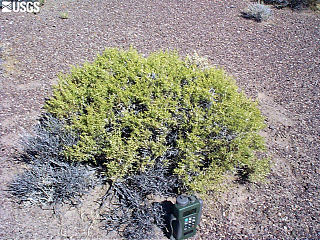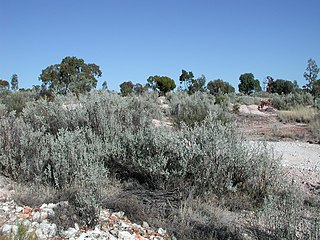
Amaranthaceae is a family of flowering plants commonly known as the amaranth family, in reference to its type genus Amaranthus. It includes the former goosefoot family Chenopodiaceae and contains about 165 genera and 2,040 species, making it the most species-rich lineage within its parent order, Caryophyllales.

Alternanthera is a genus of flowering plants in the family Amaranthaceae. It is a widespread genus with most species occurring in the tropical Americas, and others in Asia, Africa, and Australia. Plants of the genus may be known generally as joyweeds, or Joseph's coat. Several species are notorious noxious weeds.

Atriplex is a plant genus of about 250 species, known by the common names of saltbush and orache. It belongs to the subfamily Chenopodioideae of the family Amaranthaceae s.l.. The genus is quite variable and widely distributed. It includes many desert and seashore plants and halophytes, as well as plants of moist environments. The generic name originated in Latin and was applied by Pliny the Elder to the edible oraches. The name saltbush derives from the fact that the plants retain salt in their leaves; they are able to grow in areas affected by soil salination.

Chenopodium is a genus of numerous species of perennial or annual herbaceous flowering plants known as the goosefoot, which occur almost anywhere in the world. It is placed in the family Amaranthaceae in the APG II system; older classification systems, notably the widely used Cronquist system, separate it and its relatives as Chenopodiaceae, but this leaves the rest of the Amaranthaceae polyphyletic. However, among the Amaranthaceae, the genus Chenopodium is the namesake member of the subfamily Chenopodioideae.

Sarcobatus is a North American genus of two species of flowering plants, formerly considered to be a single species. Common names for S. vermiculatus include greasewood, seepwood, and saltbush. Traditionally, Sarcobatus has been treated in the family Chenopodiaceae, but the APG III system of 2009 recognizes it as the sole genus in the family Sarcobataceae.

Iresine is a genus of flowering plants in the family Amaranthaceae. It contains 20 to 25 species, all of which are native to the American tropics. The generic name is derived from the Greek word εριος (erios), meaning "wooly", referring to the trichome-covered flowers. Bloodleaf is a common name for those species that have colored foliage, and these are often cultivated as ornamental plants. Some species are additives to versions of the hallucinogenic drink ayahuasca.

Eleocharis is a virtually cosmopolitan genus of 250 or more species of flowering plants in the sedge family, Cyperaceae. The name is derived from the Greek words ἕλειος (heleios), meaning "marsh dweller," and χάρις (charis), meaning "grace." Members of the genus are known commonly as spikerushes or spikesedges. The genus has a geographically cosmopolitan distribution, with centers of diversity in the Amazon Rainforest and adjacent eastern slopes of the South American Andes, northern Australia, eastern North America, California, Southern Africa, and subtropical Asia. The vast majority of Eleocharis species grow in aquatic or mesic habitats from sea level to higher than 5,000 meters in elevation.

Aerva is a genus of plants in the family Amaranthaceae. Its species are native to the palaeotropics, throughout continental Africa, Madagascar and smaller islands, through parts of the Middle East, India, and southeast Asia. Aerva javanica is an alien in northern Australia.

Atriplex hymenelytra, the desert holly, is silvery-whitish-gray shrub in the family Amaranthaceae, native to deserts of the southwestern United States. It is the most drought tolerant saltbush in North America. It can tolerate the hottest and driest sites in Death Valley, and remains active most of the year.

Baccharis sarothroides is a North American species of flowering shrub known by the common names broom baccharis, desertbroom, greasewood, rosin-bush and groundsel in English and "escoba amarga" or "romerillo" in Spanish. This is a spreading, woody shrub usually sticky with glandular secretions along the primarily leafless green stems. The small, thick leaves are a few centimeters long and are absent much of the year, giving the shrub a spindly, twiggy appearance. It flowers abundantly with tiny green blooms on separate male and female plants.

Atriplex cinerea, commonly known as grey saltbush, coast saltbush, barilla or truganini, is a plant species in the family Amaranthaceae. It occurs in sheltered coastal areas and around salt lakes in the Australian states of Western Australia, South Australia, Tasmania, Victoria and New South Wales.

Ptilotus R.Br. is a genus of approximately 120 species of annual and perennial herbs and shrubs in the family Amaranthaceae. All species are native to mainland Australia, although one species, Ptilotus spathulatus (R.Br.) Poir., also occurs in Tasmania and another, Ptilotus conicus R.Br., in Malesia on the islands of Flores and Timor. Most of the diversity is in Western Australia, particularly in the Pilbara. Common names for species in this genus include mulla mulla, foxtails, pussy tails and lamb's tails. The genus was first formally described by botanist Robert Brown in Prodromus Florae Novae Hollandiae in 1810. In family-level phylogenetic studies, Ptilotus has been placed within a clade informally known as the 'aervoids'. It has been resolved as monophyletic and is closely related to Aerva Forssk. An interactive key to the species of Ptilotus is available at KeyBase.

Aerva lanata, the mountain knotgrass, is a woody, prostrate or succulent, perennial herb in the family Amaranthaceae, native to Asia, Africa. It has been included as occurring in Australia by the US government, but it is not recognised as occurring in Australia by any Australian state herbarium. The plant sometimes flowers in the first year.

Grayia spinosa is a species of the genus Grayia in the subfamily Chenopodioideae of the flowering plant family Amaranthaceae, which is known by the common names hop sage and spiny hop sage. It is widely distributed across the Western United States, where it grows in a number of desert and mountain habitats.

Atriplex nummularia is a species of saltbush from the family Amaranthaceae and is a large woody shrub known commonly as oldman saltbush. A. nummularia is native to Australia and occurs in each of the mainland states, thriving in arid and semi-arid inland regions.

Ptilotus exaltatus, more commonly known as pink mulla mulla, is an erect annual herb endemic to large parts of arid and semi-arid Australia. It grows throughout most areas of Australia except the Nullarbor Plain, occurring geographically above a line drawn from Perth to Esperance. The species was first observed and described in 1810, and comprehensively catalogued in 1971.
Suaeda fruticosa is a species of flowering plant in the family Amaranthaceae. It is a small shrub, with very variable appearance over its wide range. It is a halophyte, and occurs in arid and semi-arid saltflats, salt marshes and similar habitats.

Ambrosia salsola, commonly called cheesebush, winged ragweed, burrobush, white burrobrush, and desert pearl, is a species of perennial shrub in the family Asteraceae native to deserts of the southwestern United States and northwestern Mexico.

Cochlospermum fraseri is a tree in the family Bixaceae with common names cotton tree, kapok bush, and kapok tree. It is native to north western Australia.

Chenopodium spinescens is a species of plant in the family Amaranthaceae and is endemic to all mainland states and territories of Australia where it is known as Rhagodia spinescens.



















